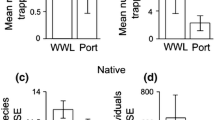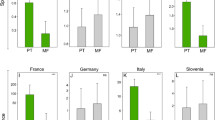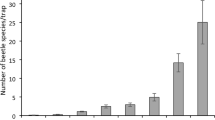Abstract
Invasive alien species cost forestry billions of euros every year and their early detection is becoming of utmost importance. The aim of this study is to improve some of the techniques available for trapping alien wood boring beetles (Scolytinae, Cerambycidae, and Buprestidae) arriving at high-risk sites, such as ports. During 2009–2011, trapping carried out in four Italian seaports tested the comparative efficiency of different luring (single-lure vs. multi-lure traps) and trap designs (cross-vane vs. multi-funnel). In addition, trap captures within the ports were compared with those obtained in surrounding areas. Six out of 49 species trapped in 3 years of investigation were of alien origin: four Scolytinae and two Cerambycidae. The number of species trapped in multi-lure traps was as high as that resulting from the sum of the single-lure traps. The two trap designs performed equally well, but multi-funnel traps were more robust and easier to use in ports. In 2011, the number of species trapped in ports and surrounding areas was similar, although differently distributed. On a total of 26 species trapped in this experiment, nine were exclusive to ports, of which three aliens, eight were exclusive to surrounding areas, of which one alien, and nine were common to both habitats, of which one alien. In conclusion, we suggest the use of multi-funnel traps baited with different lures for monitoring alien wood boring beetles in ports. Using traps outside the port is also recommended to validate the surveillance program.

Similar content being viewed by others
References
Assoporti (2012) Movimenti in principali porti italiani. http://www.assoporti.it/sites/www.assoporti.it/files/statistiche/Movimenti_portuali_%202011_26giu12.pdf. Accessed 6 Aug 2012
Bashford R (2008) The development of a port surrounds trapping system for the detection of exotic forest insect pests in Australia. In: Oteng-Amoako AA (ed) New advances and contribution to forestry research. InTech, Rijeka, pp 85–100
Britton KO, White P, Kramer A, Hudler G (2010) A new approach to stopping the spread of invasive insects and pathogens: early detection and rapid response via a global network of sentinel plantings. N Z J For Sci 40:109–114
Brockerhoff EG, Jones DC, Kimberley MO, Suckling DM, Donaldson T (2006a) Nationwide survey for invasive wood-boring and bark beetles (Coleoptera) using traps with pheromones and kairomones. For Ecol Manag 228:234–240
Brockerhoff EG, Bain J, Kimberley MO, Knizek M (2006b) Interception frequency of exotic bark and ambrosia beetles (Coleoptera: Scolytinae) and relationship with establishment in New Zealand and worldwide. Can J For Res 36:289–298
Brockerhoff EG, Suckling DM, Roques A, Jactel H, Branco M, Twidle AM, Mastro VC, Kimberley MO (2012) Improving the efficiency of lepidopteran pest detection and surveillance: constraints and opportunities for multiple-species trapping. J Chem Ecol 39:50–58
C.N.E.L. (2003) I flussi marittimi nelle filiere del legno e della carta. http://www.cnel.it/53?shadow_documenti=10850. Accessed 10 Sep 2012
Czokajlo D, Teale SA (1999) Synergistic effect of ethanol to α-pinene in primary attraction of the larger pine shoot beetle, Tomicus piniperda. J Chem Ecol 25:1121–1130
de Groot P, Nott RW (2003) Response of Monochamus (Col., Cerambycidae) and some Buprestidae to flight intercept traps. J Appl Entomol 127:548–552
Dodds KJ, Dubois GD, Hoebeke ER (2010) Trap type, lure placement and habitat effects on Cerambycidae and Scolytinae (Coleoptera) catches in the Northeastern United States. J Econ Entomol 103:698–707
Faccoli M, Frigimelica G, Mori N, Petrucco Toffolo E, Vettorazzo M, Simonato M (2009) First record of Ambrosiodmus (Hopkins, 1915) (Coleoptera: Curculionidae, Scolytinae) in Europe. Zootaxa 2303:57–60
Faccoli M, Simonato M, Petrucco Toffolo E (2012) First record of Cyrtogenius Strohmeyer in Europe, with a key to the European genera of the tribe Dryocoetini (Coleoptera: Curculionidae, Scolytinae). Zootaxa 3423:27–35
FAO (2011) International standards for phytosanitary measures. ISPM 6: guidelines for surveillance (1997). Rome, Italy
Flechtmann CAH, Ottati ALT, Berisford CW (2000) Comparison of four trap types for ambrosia beetles (Coleoptera, Scolytidae) in Brazilian Eucalyptus stands. J Econ Entomol 93:1701–1707
Francardi V, de Silva J, Pennacchio F, Roversi PF (2009) Pine volatiles and terpenoid compounds attractive to European xylophagous species, vectors of Bursaphelenchus spp. nematodes. Phytoparasitica 37:295–302
Haack RA (2001) Intercepted Scolytidae (Coleoptera) at US ports of entry: 1985–2000. Integr Pest Manag Rev 6:253–282
Haack RA (2006) Exotic bark- and wood-boring Coleoptera in the United States: recent establishments and interceptions. Can J For Res 36:269–288
Holmes PT, Aukema JE, Von Holle B, Liebhold A, Sills E (2009) Economic impacts of invasive species in forest: past, present and future. In: Ostfeld RS, Schlesinger WH (eds) The year in ecology and conservation biology. Wiley-Blackwell, Hoboken, pp 18–38
Ibeas F, Gallego D, Diez JJ, Pajares JA (2007) An operative kairomonal lure for managing pine sawyer beetle Monochamus galloprovincialis (Coleoptera: Cerambycidae). J Appl Entomol 131:13–20
Johansson BG, Anderbrant O, Sierpinski A (2002) Multispecies trapping of six pests of Scots pine in Sweden and Poland. J Appl Entomol 126:212–216
Kirkendall LR, Faccoli M (2010) Bark beetles and pinhole borers (Curculionidae, Scolytinae, Platipodynae) alien to Europe. ZooKeys 56:227–251
Liebhold AM, Tobin PC (2008) Population ecology of insect invasions and their management. Annu Rev Entomol 53:387–408
Marini L, Haack RA, Rabaglia RJ, Petrucco Toffolo E, Battisti A, Faccoli M (2011) Exploring associations between international trade and environmental factors with establishment patterns of alien Scolytinae. Biol Invasions 13:2275–2288
Miller DR, Rabaglia RJ (2009) Ethanol and (−)-α-pinene: attractant kairomones for bark and ambrosia beetles in the southeastern US. J Chem Ecol 35:435–448
Miller DR, Asaro C, Crowe CM, Duerr DA (2011) Bark beetle pheromones and pine volatiles: attractant kairomone lure blend for longhorn beetles (Cerambycidae) in pine stands of the southeastern United States. J Econ Entomol 104:1245–1257
Morewood WD, Hein KE, Katinic PJ, Borden JH (2002) An improved trap for large wood-boring insects, with special reference to Monochamus scutellatus (Coleoptera: Cerambycidae). Can J For Res 32:519–525
Petrice TR, Haack RA, Poland TM (2004) Evaluation of three trap types and five lures for monitoring Hylurgus ligniperda (Coleoptera: Scolytidae) and other local scolytids in New York. Gt Lakes Entomol 37:1–9
Pimentel D, Zuniga R, Morrison D (2005) Update on the environmental and economic costs associated with alien-invasive species in the United States. Ecol Econ 52:273–288
R Development Core Team (2011) R: a language and environment for statistical computing. R Foundation for Statistical Computing, Vienna. ISBN 3-900051-07-0. http://wwwR-projectorg. Accessed 13 Aug 2012
Rabaglia RJ, Duerr D, Acciavatti RE, Ragenovich I (2008) Early detection and rapid response for non-native bark and ambrosia beetles. US Department of Agriculture Forest Service, Forest Health Protection, Washington, DC
Roques A (2010a) Taxonomy, time and geographic patterns. In: Roques A et al (eds) Alien terrestrial arthropods of Europe. BioRisk, vol 4. Pensoft Publishers, Sofia, pp 11–26
Roques A (2010b) Alien forest insects in a warmer world and a globalized economy: impacts of changes in trade, tourism and climate on forest biosecurity. N Z J For 40(suppl):77–94
Roques A, Auger-Rozenberg MA (2006) Tentative analysis of the interceptions of nonindigenous organisms in Europe during 1995–2004. EPPO Bull 36:490–496
Sauvard D, Branco M, Lakatos F, Faccoli M, Kirkendall L (2010) Weevils and bark beetles (Coleoptera, Curculionidae). In: Roques A et al (eds) Alien terrestrial arthropods of Europe. BioRisk, vol 4. Pensoft Publishers, Sofia, pp 219–266
Schroeder LM, Lindelöw A (1989) Attraction of scolytids and associated beetles by different absolute amounts and proportions of α-pinene and ethanol. J Chem Ecol 15:807–817
Schwalbe CP, Mastro VC (1988) Multispecific trapping techniques for exotic-pest detection. Agric Ecosyst Environ 21:43–51
Stone C, Goodyer G, Sims K, Penman P, Carnegie A (2010) Beetle assemblages captured using static panel traps within New South Wales pine plantations. Aust J Entomol 49:304–316
Tkacz BM (2002) Pest risks associated with importing wood to the United States. Can J Plant Pathol 24:111–116
Vilà M, Basnou C, Pyšek P, Josefsson M, Genovesi P, Gollasch S, Nentwig W, Olenin S, Roques A, Roy D, Hulme PE (2009) How well do we understand the impacts of alien species on ecosystem services? A pan-European, cross-taxa assessment. Front Ecol Environ 8:135–144
Vité JP, Bakke A, Renwick JAA (1972) Pheromones in Ips (Coleoptera: Scolytidae): occurrence and production. Can Entomol 104:1967–1975
Wong JCH, Mitchell RF, Striman BL, Millar JG, Hanks LM (2012) Blending synthetic pheromones of cerambycid beetles to develop trap lures that simultaneously attract multiple species. J Econ Entomol 105:906–915
Wylie FR, Griffiths M, King J (2008) Development of hazard site surveillance programs for forest invasive species: a case study from Brisbane, Australia. Aust For 71:229–235
Acknowledgments
The authors thank the Regional Plant Protection Organizations of Friuli Venezia Giulia and Veneto Regions for the collaboration during the research and Lorenzo Marini for the help in data analyses. This study was supported by the EU Seventh Research Framework Program (FP7) projects Q-DETECT (Development of detection methods for quarantine plant pests for use by plant health inspection services—Grant No. 245047) and PRATIQUE (Enhancements of pest risk analysis techniques—Grant No. 212459).
Author information
Authors and Affiliations
Corresponding author
Additional information
Communicated by M. Traugott.
Rights and permissions
About this article
Cite this article
Rassati, D., Petrucco Toffolo, E., Roques, A. et al. Trapping wood boring beetles in Italian ports: a pilot study. J Pest Sci 87, 61–69 (2014). https://doi.org/10.1007/s10340-013-0499-5
Received:
Accepted:
Published:
Issue Date:
DOI: https://doi.org/10.1007/s10340-013-0499-5




